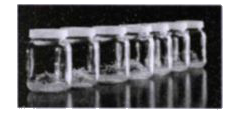The rate of increase in the number of bacteria in a certain bacteria culture is proportional to the number present. If in 5 hrs the number triples, then in 10 hrs, the number of bacteria present is
18 times the original
12 times the original
6 times the original
9 times the original
The correct Answer is:D
Step by step video, text & image solution for The rate of increase in the number of bacteria in a certain bacteria culture is proportional to the number present. If in 5 hrs the number triples, then in 10 hrs, the number of bacteria present is by Maths experts to help you in doubts & scoring excellent marks in Class 12 exams.
Updated on:21/07/2023Topper's Solved these Questions
- MHT-CET 2019 QUESTION PAPER BOOK - TARGET PUBLICATIONCHAPTER - MHT-CET 2019 QUESTION PAPER EXERCISE - Probability Distribution
1 Videos
- MHT-CET 2019 QUESTION PAPER BOOK - TARGET PUBLICATIONCHAPTER - MHT-CET 2019 QUESTION PAPER EXERCISE - Binomial Distribution
1 Videos
- MHT-CET 2019 QUESTION PAPER BOOK - TARGET PUBLICATIONCHAPTER - MHT-CET 2019 QUESTION PAPER EXERCISE - Applications of Definite Integral
1 Videos
- MATRICESBOOK - TARGET PUBLICATIONCHAPTER - MATRICESEXERCISE - EVALUATION TEST
13 Videos
- MODEL QUESTION PAPER-IBOOK - TARGET PUBLICATIONCHAPTER - MODEL QUESTION PAPER-IEXERCISE - MCQs
48 Videos
Similar Questions
The rate of increase in the number of bacteria in a certain bacteria culture is proportional to the number present. Given the number triples in 5 hrs., find how many bacteria will be present after 10 hours. Also find the time necessary for the number of bacteria to be 10 times the number of initial present. [Given loge3=1.0986, e2.1972=9 ]
View SolutionThe rate of increases of bacteria in a certain culture is proportional to the number present. If it doubles in 5 hr., then in 25 hr., its number would be
View Solution
Knowledge Check
Read the following text and answer the following questions on the basis of the same: The rate of increase in the number of bacteria in a certain bacteria culture is proportional to the number present. Given that the number triples in 5 hours.

If 'N' is the number of bacteria, the corresponding differential equation is ____________ .AdNdt=KtBdNdt=KNCdKdt=NDdKdN=tRead the following text and answer the following questions on the basis of the same: The rate of increase in the number of bacteria in a certain bacteria culture is proportional to the number present. Given that the number triples in 5 hours.

The bacteria becomes 10 times in ___________ hours.A5log7B5log10log3C5log3Dlog(1053)Read the following text and answer the following questions on the basis of the same: The rate of increase in the number of bacteria in a certain bacteria culture is proportional to the number present. Given that the number triples in 5 hours.

If N0 is the initial count of bacteria, after 10 hours the count is __________ .A15log3B3logN0C9N0D2N0
Read the following text and answer the following questions on the basis of the same: The rate of increase in the number of bacteria in a certain bacteria culture is proportional to the number present. Given that the number triples in 5 hours.

The general solution is _________ .
View Solution∫1Kxdx=_________ .
View SolutionThe rate of increase in the number of bacterai in a certain becteria culture is propotional to the number present at that time. If is found that the number doubles in 4 hours, then at the end of 12 hours, the number of bacteria are
View SolutionThe rate of increase in the number of bacteriad in a certain bacteria culture is propotional to the number present at that time. After 2 hours there are 600 becteria and after 8 hours the count is 75000, then the initial population is
View SolutionThe rate of increase in the number of bacteria in a certain becteria culture is propotional to the number present at that time. If initiallly there are 300 bacteria and after 2 hours, the bacteria polulation is increased by 20% then after 24 houre, the number of bacteria are (log1.2=0.18232,e2.18784=8.9166)
View Solution
